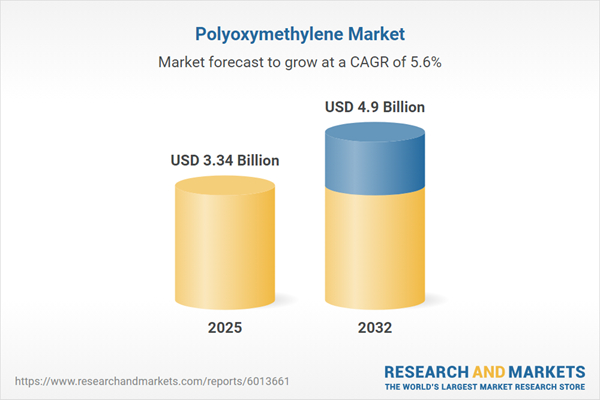Speak directly to the analyst to clarify any post sales queries you may have.
Polyoxymethylene is becoming central to supply chain strategies for industries that demand resilience and operational excellence. As regulatory environments become more complex and technology steadily advances, this adaptable polymer supports senior leaders in safeguarding process integrity and meeting competitive challenges. The following analysis is tailored for executive-level stakeholders evaluating material solutions to fortify manufacturing operations amidst ongoing market uncertainties.
Market Snapshot: Polyoxymethylene Market Growth and Dynamics
The global polyoxymethylene market continues on a sustained growth trajectory, reaching an estimated value of USD 3.16 billion in 2024, with a projection of USD 3.34 billion by 2025. The market’s long-term outlook anticipates expansion to USD 4.90 billion in 2032, underpinned by a robust compound annual growth rate (CAGR) of 5.62%.
This upward trend is supported by rising adoption across automotive, electrical, electronics, and manufacturing sectors. Companies are reinforcing local production capabilities, investing in process enhancements, and building strategic partnerships to adapt to regulatory change and guarantee quality consistency. As client expectations evolve, supply chain resilience and accelerated new product launches have become focal points, helping organizations remain agile in a rapidly changing marketplace.
Scope & Segmentation of the Polyoxymethylene Market
This report delivers actionable direction for procurement, research, and executive strategy. It maps the key segments shaping the polyoxymethylene market’s strategic landscape and technological momentum:
- Resin Types: Copolymer and homopolymer forms enable customization for diverse functional and mechanical targets throughout various industries.
- Grades: Standard and high-performance grades address compliance needs and assure quality for regulated or sensitive applications.
- Forms: Granules, pellets, and powders ensure process compatibility for injection molding, extrusion, and advanced manufacturing approaches.
- Distribution Channels: Direct supplier contracts and collaborative sourcing models are vital for material access, stable production, and supply chain risk management.
- Applications: Polyoxymethylene is integral in automotive assemblies, electronics, industrial machinery, medical devices, and consumer goods, focusing on reliability and compliance across end-use sectors.
- Regions: The Americas, EMEA, and Asia-Pacific markets receive dedicated analysis, supporting informed decisions on localization, compliance, and risk strategy in both developed and emerging economies.
- Key Companies: Profiles of Celanese Corporation, Polyplastics Co., Ltd., DuPont de Nemours, BASF SE, Mitsubishi Engineering-Plastics Corp, Sumitomo Chemical, Formosa Plastics, Daicel Corporation, LG Chem, and Lotte Chemical examine innovation pathways and market positioning.
Key Takeaways for Senior Decision-Makers
- Integrating polyoxymethylene into manufacturing processes advances operational precision and supply chain reliability—especially in sectors introducing digital transformation and automation.
- Expansion of advanced production and automation enhances security of supply, while supporting progress toward broader sustainability initiatives for manufacturing groups.
- Ongoing regulatory evolution, particularly across EMEA and North America, necessitates adjustment of sourcing strategies and inventory frameworks, helping organizations develop stronger risk resilience.
- Strategic partnerships in research and development accelerate the delivery of tailored polymer solutions, resulting in increased flexibility for suppliers and end users.
- Regional dynamics show Asia-Pacific companies investing in expansion and collaboration, while stakeholders in EMEA and the Americas emphasize compliance-driven procurement and refined risk management models.
Tariff Impact: Navigating U.S. Trade Policy Changes
Recent changes in U.S. tariff policies are influencing polyoxymethylene supply strategies. Companies are responding by ramping up local production, diversifying sourcing, and fostering closer supplier ties. This approach improves resilience to supply disruptions and helps control costs through a mix of contract structures and proactive risk management measures.
Methodology & Data Sources
This report integrates insights drawn from resin producers, equipment suppliers, and regulatory entities. Standardized industry benchmarks, patent reviews, and audited financial statements are peer-reviewed for a comprehensive and reliable foundation supporting strategic planning needs.
Why This Polyoxymethylene Market Report Matters
- Equip leadership teams with up-to-date risk management strategies and the foresight necessary to navigate fast-changing market and compliance landscapes.
- Receive clear guidance on optimizing processes, implementing production upgrades, and aligning compliance frameworks with current and future regulatory demands worldwide.
- Adopt unified sourcing and sustainability strategies that reduce operational interruptions and maintain alignment with evolving sector targets.
Conclusion
By placing polyoxymethylene at the core of industrial planning, senior leaders can effectively address regulatory and operational change, maintaining enterprise resilience and sustaining competitive positioning as sector dynamics evolve.
Additional Product Information:
- Purchase of this report includes 1 year online access with quarterly updates.
- This report can be updated on request. Please contact our Customer Experience team using the Ask a Question widget on our website.
Table of Contents
3. Executive Summary
4. Market Overview
7. Cumulative Impact of Artificial Intelligence 2025
Companies Mentioned
The companies profiled in this Polyoxymethylene market report include:- Celanese Corporation
- Polyplastics Co., Ltd.
- DuPont de Nemours, Inc.
- BASF SE
- Mitsubishi Engineering-Plastics Corporation
- Sumitomo Chemical Co., Ltd.
- Formosa Plastics Corporation
- Daicel Corporation
- LG Chem Ltd.
- Lotte Chemical Corporation
Table Information
| Report Attribute | Details |
|---|---|
| No. of Pages | 181 |
| Published | November 2025 |
| Forecast Period | 2025 - 2032 |
| Estimated Market Value ( USD | $ 3.34 Billion |
| Forecasted Market Value ( USD | $ 4.9 Billion |
| Compound Annual Growth Rate | 5.6% |
| Regions Covered | Global |
| No. of Companies Mentioned | 11 |









